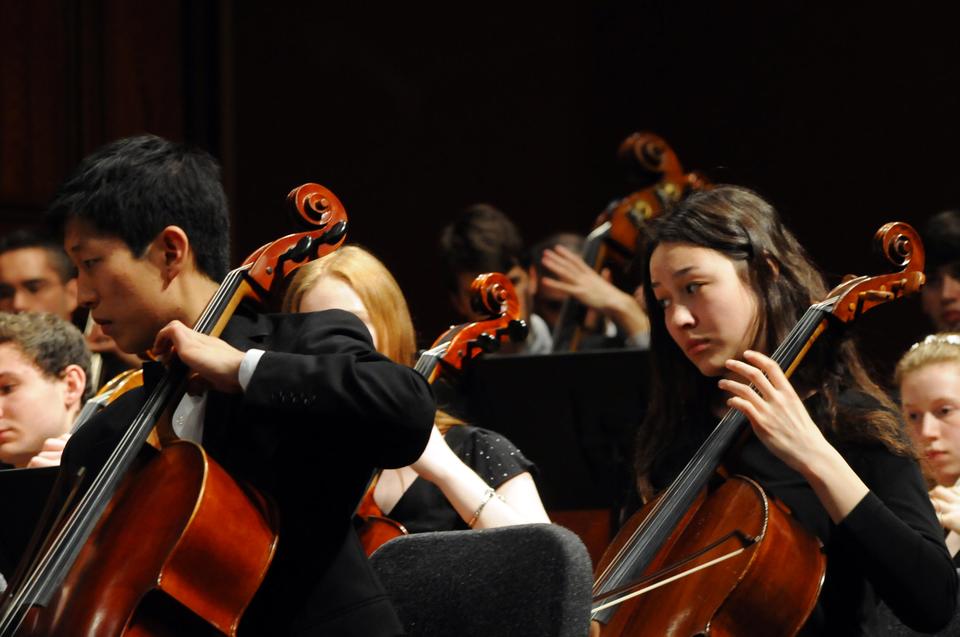
News
Summers Will Not Finish Semester of Teaching as Harvard Investigates Epstein Ties

News
Harvard College Students Report Favoring Divestment from Israel in HUA Survey

News
‘He Should Resign’: Harvard Undergrads Take Hard Line Against Summers Over Epstein Scandal

News
Harvard To Launch New Investigation Into Epstein’s Ties to Summers, Other University Affiliates

News
Harvard Students To Vote on Divestment From Israel in Inaugural HUA Election Survey
HRO Performs Challenging Program With Solid Results

On Saturday, the Harvard-Radcliffe Orchestra tackled the latest in a series of ambitious programs, performing Leonard Bernstein’s Overture to “Candide”, as well as “Short Ride in a Fast Machine” by John Adams ’71 and Johannes Brahms’s 4th Symphony. While the consistent brilliance of the HRO’s string section made for an enjoyable, impressive performance, the brass and wind sections at times failed to match the strings’ dynamic ability and technical precision, holding the orchestra back from its full potential.
The concert began with a near-perfect rendition of Bernstein’s Overture. Through precise control of dynamics, HRO conductor Federico Cortese guided the orchestra’s performance toward a playful mood rather than a bombastic or overwrought one—a decision that made the piece even more enjoyable. The strings effortlessly alternated between soaring crescendos, intricate pizzicato, and, most impressively, the blisteringly rapid unison runs that make up the Overture’s Theme, which are difficult play accurately for even the most experienced performers. Although short and familiar, the Overture is a deceptively difficult piece, and the HRO dazzled through nuanced interpretation and accomplished technical execution.
The second composition on the program, Adams’ “Short Ride in a Fast Machine,” was less successful. A quality performance of the piece depends heavily on the brass section’s ability to build dynamic tension and to articulate rhythmic dissonance through rapid, distinct pulses. However, throughout the majority of the performance, the HRO’s brass was muddled, robbing the piece of its rhythmic tension. In the normally inspiring finale, the brass was simply too soft to rise above the other sections and provide the requisite drama. Adams’ work is challenging to perform, more so than that of his minimalist contemporaries Philip Glass and Steve Reich because it hinges on engrossing the listener with precisely-balanced musical textures. Although the rendition of the piece was generally good, it was not quite at the level of a professional performance. Compared to the San Francisco Symphony, which is well known for its successful renditions of Adams’ compositions, the HRO’s rendition of the composer’s dramatic style fell short.
While the first two pieces lasted only about eight minutes, the final work, Brahms’ Symphony No. 4 in E minor, lasted over 40. Although technically accomplished, the HRO’s performance lagged in the less riveting and emotionally powerful sections of the Symphony. For example, during the symphony’s least intense movement, the second, the HRO sounded drowsy and disinterested, as if its performers were merely waiting to get to the monumental fourth movement, during which the orchestra regained its energy and delivered a rousing finale. Even within single movements, this problematic trend remained; the loud, dramatic sections were expertly managed, but the performance would have benefited if much more attention had been invested in capturing the emotions found in the softer sections.
The gap in musicianship and technical skill between the strings and the rest of the orchestra persisted throughout the symphony. The strings were mostly excellent throughout, even providing some jaw-dropping moments such as the wonderfully formed interplay between the violins and cellos during the third movement. However, the brass and wind sections were missing the same overall level of precision. At times, their collective timing felt disjointed; at others, their lack of dynamic range contributed to the performance’s drowsy feel.
While the issues with the brass were problematic, they were not fatal to the concert. Rather, they merely kept a very good performance of the symphony from becoming an excellent one.
—Staff writer Will Holub-Moorman can be reached at holubmoorman@college.harvard.edu.
Want to keep up with breaking news? Subscribe to our email newsletter.
